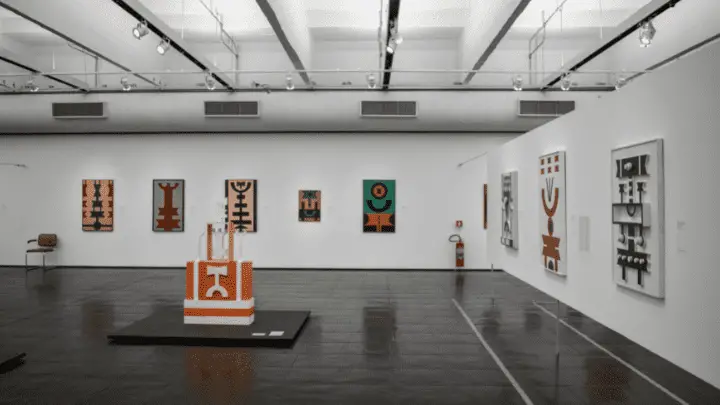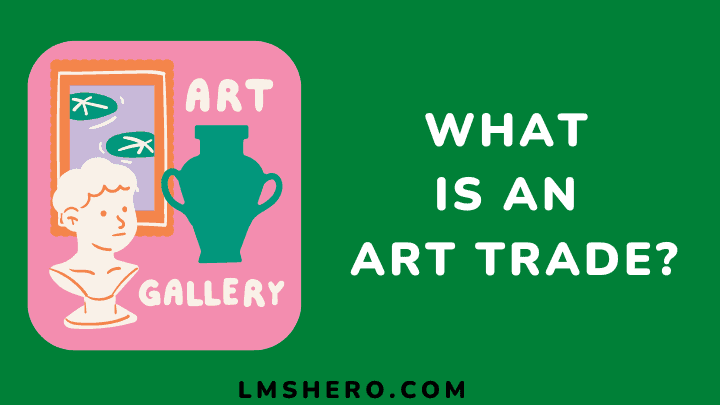Art is big business. And for many artists, especially those working with physical mediums such as paintings or sculptures, the art trade can be lucrative and exciting.
But it’s also complex and challenging, fraught with risks and uncertainties. That’s why it’s important to understand the basics of the art trade before jumping into it.
In this article, I will provide a brief overview of the art trade, including its aim and how it works, and tips you should take if you want to enter it successfully.
What is an art trade?
An art trade is a business in the arts. The term usually refers to the market for fine art, but the term can be applied to any type of artistic production.
In the fine art world, an art trade can refer to selling paintings, drawings, sculptures, or intellectual property, such as copyrights or trademarks.
The trade between individuals, businesses, or organizations can be physical or online and may involve various intermediaries, such as auction houses, galleries, or dealers.
An art trade can also involve licensing artwork in advertisements, packaging, and other products.
What is the aim of an artwork trade?
An art trade aims to enable people to interact and trade art fairly and equitably. This helps increase the value of a particular piece of art while reducing the chances that it will be stolen or illegally sold.
An art trade is a three-way transaction in which an artist provides his or her work, a buyer acquires the work, and the artist receives money.
Typically, an art trade works like this: an artist creates a piece of art and puts it up for sale on a website or in a gallery. They may also put it up for auction or give it away as part of a residency.
Once it’s up for sale, people can bid on it, and the person who bids the highest amount gets to purchase the artwork.
The beauty of the art trade is that it allows artists to quickly get their work in front of a large audience.
Plus, buyers can always ensure they get high-quality art at a fair price. There are plenty of opportunities for both parties to benefit from a successful art trade.
What is the importance of the art trade in the modern world?
Art has always been an important way to communicate and connect with others. From the cave paintings of prehistoric man to the works of modern-day artists, art has always been a means of expression and communication.
Today, the art trade is even more important than ever. This is because art can be a tool for understanding and communication between cultures in today’s global world.
It helps to connect people, brings people together, and can transform the entire mood of a room. Movies, music, and paintings all have the power to move and inspire us, and we must continue to support the art trade.
Many talented artists need our help, and we should do everything we can to help them reach wider audiences.
If you’ve ever been moved by art, consider donating to the art trade. It’s an important contribution to the world and will help make life more beautiful.
Art trade preparation tips for artists

1. Have confidence in yourself and your work
As an artist, you must have confidence in yourself and your work to create great art. Confidence comes from knowing you have what it takes to succeed and do the job well.
It’s important to develop a strong self-image internally (impressions you have of yourself) and externally (what others think about you).
Self-confidence is essential for artists because it gives them the conviction to push ahead even when things look difficult.
When you know you can do the job, staying focused and passionate is easier, no matter the challenge. So, don’t be afraid to put in the extra effort – it will pay off in the long run.
2. Study the market demand for your art niche
Studying the market demand for your art niche is an important art trade preparation tip for artists.
By understanding what people are looking for in your genre, you can create products that will satiate that demand and sell well.
This is particularly important if you anticipate selling your work internationally, as different markets will have different buying habits.
By familiarizing yourself with the demands of different markets, you can make informed decisions and ensure that your art travels well and achieves maximum sales potential.
3. Be smart about your pricing
Pricing your artwork is one of the most important decisions you’ll ever make as an artist. The wrong price can damage your reputation, while a high price can discourage potential buyers.
The per-project rate method is an effective method to set the right price. It is simply charging for your piece of art based on estimated hours to completion multiplied by an hourly rate.
Other things to consider include:
- Your target market: what are they willing to pay for your product?
- The production costs: how much does it cost you to produce your product?
- Your competition: what are their prices?
- Your profit margins: how much can you comfortably earn from each sale?
Another strategy is to charge based on the size of your piece. Larger pieces require more paint, materials, handling, and shipping costs, hence a higher rate.
4. Get professional marketing advice
Getting professional marketing advice is an important step for any artist. With the guidance of a skilled professional, it can be easier to create effective marketing campaigns and build a following.
With the help of a professional, artists can target their audience, set realistic prices, and create a product tailored to their fans’ needs.
Additionally, working with a professional will increase the chances of success when launching a new project – an exhibition or a crowdfunding campaign.
5. Get ready to network and build relationships with other artists at the show
Networking and building relationships with other artists are important for many reasons. First, it helps you to find partners who can help promote your work.
Second, it allows you to build relationships that can lead to commissions or other opportunities.
And finally, networking and building relationships with other artists helps you to learn more about the art industry and what you need to know to be successful.
So not only is networking and building relationships important for your career, but it’s also important for your personal development as an artist.
FAQs
Is an art trade easy to organize?
Putting together an art trade can be daunting, but it’s possible with the right planning and modalities.
What should you do before getting into an art trade?
Before getting into the art trade, it’s important to do your research. You should know what you’re getting into and be prepared to invest long-term.
What is the online art community like?
The online art community is as diverse and unique as the people participating. The common themes you’ll notice include creativity, collaboration, and diversity. An online community will be helpful to both expert artists and beginners.
How do you get into the art community?
To get into the art community, you first need to be an artist. And to be an artist, you need to create art. Just like any other skill, practice makes perfect. Once you’re good enough, you can start showing your work to other artists, who can help you find a wider audience.
Final thoughts
The art trade is a multimillion-dollar business that will remain so even in the future. The ever-growing global market for art means that more and more collectors are looking for opportunities to buy and sell art.
However, it’s also turbulent, characterized by boom and bust cycles and ever-changing prices. It’s no wonder many artists are wary of participating in it.
But as this article shows, there are tips to prepare and make money from the art trade without getting involved in the more complicated aspects of the trade.
By understanding how the market works and being realistic about what can and cannot be done, artists can put their fears to rest and get started on their next project.
A good strategy for making the most of an art trade may be to learn more about how art galleries make money.
Thanks for reading.






